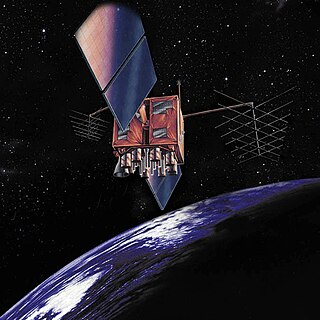
Fēngyún are China's meteorological satellites. Launched since 1988 into polar sun-synchronous and geosynchronous orbit, each three-axis stabilized Fengyun satellite is built by the Shanghai Academy of Spaceflight Technology (SAST) and operated by the China Meteorological Administration (CMA). To date, China has launched twenty-one Fengyun satellites in four classes. Fengyun 1 and Fengyun 3 satellites are in polar, sun-synchronous orbit and Low Earth orbit while Fengyun 2 and 4 are geosynchronous orbit.

Skynet 5B is a military communications satellite operated by Astrium Services, formerly Paradigm Secure Communications, on behalf of the British Ministry of Defence. It was the second of four Skynet 5 satellites to be launched.

TDRS-10, known before launch as TDRS-J, is an American communications satellite which is operated by NASA as part of the Tracking and Data Relay Satellite System. It was constructed by the Boeing Satellite Development Center, formerly Hughes Space and Communications, and is based on the BSS-601 satellite bus. It was the third and final Advanced TDRS, or second-generation Tracking and Data Relay Satellite, to be launched.

GOES-2, known as GOES-B before becoming operational, was a geostationary weather satellite which was operated by the United States National Oceanic and Atmospheric Administration as part of the Geostationary Operational Environmental Satellite system. GOES-2 was built by Ford Aerospace, and was based on the satellite bus developed for the Synchronous Meteorological Satellite programme. At launch it had a mass of 295 kilograms (650 lb). It was positioned in geostationary orbit, from where it was used for weather forecasting in the United States. Following its retirement as a weather satellite, it was used as a communications satellite until its final decommissioning in 2001.
Kosmos 319, known before launch as DS-P1-Yu No.25, was a Soviet satellite which was launched in 1970 as part of the Dnepropetrovsk Sputnik programme. It was a 250-kilogram (550 lb) spacecraft, which was built by the Yuzhnoye Design Bureau, and was used as a radar calibration target for anti-ballistic missile tests.
Kosmos 458, known before launch as DS-P1-Yu No.53, was a Soviet satellite which was launched in 1971 as part of the Dnepropetrovsk Sputnik programme. It was a 325-kilogram (717 lb) spacecraft, which was built by the Yuzhnoye Design Bureau, and was used as a radar calibration target for anti-ballistic missile tests.
Globus-1M #12L or No.12L, also known as Raduga-1M 2 is a Russian military communications satellite which is operated by the Russian Space Forces. It was the second Raduga-1M satellite to be launched – the first being Globus-1M #11L which was launched in 2008, and forms part of the Raduga satellite system. It is positioned in geostationary orbit at a longitude of 70 degrees East.

Fengyun 2-07 or FY-2-07, also known as Fengyun-2F or FY-2F, is a Chinese weather satellite operated by China's National Satellite Meteorological Centre. Part of the Fengyun programme, it was the sixth Fengyun 2 geostationary satellite to be launched.

USA-154, also known as GPS IIR-6 and GPS SVN-41, is an American navigation satellite which forms part of the Global Positioning System. It was the sixth Block IIR GPS satellite to be launched, out of thirteen in the original configuration, and twenty one overall. It was built by Lockheed Martin, using the AS-4000 satellite bus.

USA-156, also known as GPS IIR-7 and GPS SVN-54, is an American navigation satellite which forms part of the Global Positioning System. It was the seventh Block IIR GPS satellite to be launched, out of thirteen in the original configuration, and twenty one overall. It was built by Lockheed Martin, using the AS-4000 satellite bus.

USA-166, also known as GPS IIR-8 and GPS SVN-56, is an American navigation satellite which forms part of the Global Positioning System. It was the eighth Block IIR GPS satellite to be launched, out of thirteen in the original configuration, and twenty one overall. It was built by Lockheed Martin, using the AS-4000 satellite bus.

USA-168, also known as GPS IIR-9 and GPS SVN-45, is an American navigation satellite which forms part of the Global Positioning System. It was the ninth Block IIR GPS satellite to be launched, out of thirteen in the original configuration, and twenty one overall. It was built by Lockheed Martin, using the AS-4000 satellite bus.

USA-175, also known as GPS IIR-10 and GPS SVN-47, is an American navigation satellite which forms part of the Global Positioning System. It was the tenth Block IIR GPS satellite to be launched, out of thirteen in the original configuration, and twenty one overall. It was built by Lockheed Martin, using the AS-4000 satellite bus.

USA-177, also known as GPS IIR-11 and GPS SVN-59, is an American navigation satellite which forms part of the Global Positioning System. It was the eleventh Block IIR GPS satellite to be launched, out of thirteen in the original configuration, and twenty one overall. It was built by Lockheed Martin, using the AS-4000 satellite bus.

USA-180, also known as GPS IIR-13 and GPS SVN-61, is an American navigation satellite which forms part of the Global Positioning System. It was the thirteenth of twenty one Block IIR GPS satellites to be launched, and the last in the original configuration. It was built by Lockheed Martin, using the AS-4000 satellite bus.
Intelsat 601, previously named Intelsat VI F-1, was a communications satellite operated by Intelsat, and later Europe*Star. Launched in 1991, it was the last of five Intelsat VI satellites to be launched. The Intelsat VI series was constructed by Hughes Aircraft, based on the HS-389 satellite bus.
Intelsat 605, previously named Intelsat VI F-5, was a communications satellite operated by Intelsat. Launched in 1991, it was the fourth of five Intelsat VI satellites to be launched. The Intelsat VI series was constructed by Hughes Aircraft, based on the HS-389 satellite bus.





